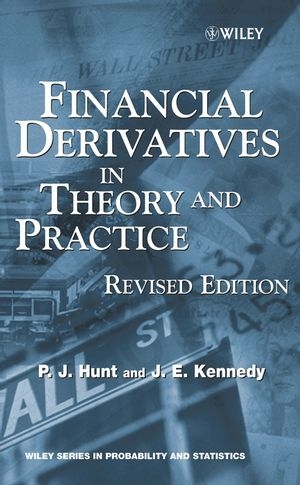
Financial Derivatives in Theory and Practice
John Wiley & Sons Inc (Verlag)
978-0-470-86358-9 (ISBN)
The term Financial Derivative is a very broad term which has come to mean any financial transaction whose value depends on the underlying value of the asset concerned. Sophisticated statistical modelling of derivatives enables practitioners in the banking industry to reduce financial risk and ultimately increase profits made from these transactions. The book originally published in March 2000 to widespread acclaim. This revised edition has been updated with minor corrections and new references, and now includes a chapter of exercises and solutions, enabling use as a course text.
Comprehensive introduction to the theory and practice of financial derivatives.
Discusses and elaborates on the theory of interest rate derivatives, an area of increasing interest.
Divided into two self-contained parts ? the first concentrating on the theory of stochastic calculus, and the second describes in detail the pricing of a number of different derivatives in practice.
Written by well respected academics with experience in the banking industry.
A valuable text for practitioners in research departments of all banking and finance sectors. Academic researchers and graduate students working in mathematical finance.
Philip Hunt is the author of Financial Derivatives in Theory and Practice, Revised Edition, published by Wiley. Joanne Kennedy is the author of Financial Derivatives in Theory and Practice, Revised Edition, published by Wiley.
Preface to revised edition. Preface.
Acknowledgements.
Part I: Theory.
1 Single-Period Option Pricing.
1.1 Option pricing in a nutshell.
1.2 The simplest setting.
1.3 General one-period economy.
1.4 A two-period example.
2 Brownian Motion.
2.1 Introduction.
2.2 Definition and existence.
2.3 Basic properties of Brownian motion.
2.4 Strong Markov property.
3 Martingales.
3.1 Definition and basic properties.
3.2 Classes of martingales.
3.3 Stopping times and the optional sampling theorem.
3.4 Variation, quadratic variation and integration.
3.5 Local martingales and semimartingales.
3.6 Supermartingales and the Doob—Meyer decomposition.
4 Stochastic Integration.
4.1 Outline.
4.2 Predictable processes.
4.3 Stochastic integrals: the L2 theory.
4.4 Properties of the stochastic integral.
4.5 Extensions via localization.
4.6 Stochastic calculus: Itô’s formula.
5 Girsanov and Martingale Representation.
5.1 Equivalent probability measures and the Radon—Nikodým derivative.
5.1.1 Basic results and properties.
5.2 Girsanov’s theorem.
5.3 Martingale representation theorem.
6 Stochastic Differential Equations.
6.1 Introduction.
6.2 Formal definition of an SDE.
6.3 An aside on the canonical set-up.
6.4 Weak and strong solutions.
6.5 Establishing existence and uniqueness: Itô theory.
6.6 Strong Markov property.
6.7 Martingale representation revisited.
7 Option Pricing in Continuous Time.
7.1 Asset price processes and trading strategies.
7.2 Pricing European options.
7.3 Continuous time theory.
7.4 Extensions.
8 Dynamic Term Structure Models.
8.1 Introduction.
8.2 An economy of pure discount bonds.
8.3 Modelling the term structure.
Part II: Practice.
9 Modelling in Practice.
9.1 Introduction.
9.2 The real world is not a martingale measure.
9.3 Product-based modelling.
9.4 Local versus global calibration.
10 Basic Instruments and Terminology.
10.1 Introduction.
10.2 Deposits.
10.3 Forward rate agreements.
10.4 Interest rate swaps.
10.5 Zero coupon bonds.
10.6 Discount factors and valuation.
11 Pricing Standard Market Derivatives.
11.1 Introduction.
11.2 Forward rate agreements and swaps.
11.3 Caps and floors.
11.4 Vanilla swaptions.
11.5 Digital options.
12 Futures Contracts.
12.1 Introduction.
12.2 Futures contract definition.
12.3 Characterizing the futures price process.
12.4 Recovering the futures price process.
12.5 Relationship between forwards and futures.
Orientation: Pricing Exotic European Derivatives.
13 Terminal Swap-Rate Models.
13.1 Introduction.
13.2 Terminal time modelling.
13.3 Example terminal swap-rate models.
13.4 Arbitrage-free property of terminal swap-rate models.
13.5 Zero coupon swaptions.
14 Convexity Corrections.
14.1 Introduction.
14.2 Valuation of ‘convexity-related’ products.
14.3 Examples and extensions.
15 Implied Interest Rate Pricing Models.
15.1 Introduction.
15.2 Implying the functional form DTS.
15.3 Numerical implementation.
15.4 Irregular swaptions.
15.5 Numerical comparison of exponential and implied swap-rate models.
16 Multi-Currency Terminal Swap-Rate Models.
16.1 Introduction.
16.2 Model construction.
16.3 Examples.
16.3.1 Spread options.
Orientation: Pricing Exotic American and Path-Dependent Derivatives.
17 Short-Rate Models.
17.1 Introduction.
17.2 Well-known short-rate models.
17.3 Parameter fitting within the Vasicek—Hull—White model.
17.4 Bermudan swaptions via Vasicek—Hull—White.
18 Market Models.
18.1 Introduction.
18.2 LIBOR market models.
18.3 Regular swap-market models.
18.4 Reverse swap-market models.
19 Markov-Functional Modelling.
19.1 Introduction.
19.2 Markov-functional models.
19.3 Fitting a one-dimensional Markov-functional model to swaption prices.
19.4 Example models.
19.5 Multidimensional Markov-functional models.
19.5.1 Log-normally driven Markov-functional models.
19.6 Relationship to market models.
19.7 Mean reversion, forward volatilities and correlation.
19.7.1 Mean reversion and correlation.
19.7.2 Mean reversion and forward volatilities.
19.7.3 Mean reversion within the Markov-functional LIBOR model.
19.8 Some numerical results.
20 Exercises and Solutions.
Appendix 1: The Usual Conditions.
Appendix 2: L2 Spaces.
Appendix 3: Gaussian Calculations.
References.
Index.
| Erscheint lt. Verlag | 23.6.2004 |
|---|---|
| Reihe/Serie | Wiley Series in Probability and Statistics |
| Verlagsort | New York |
| Sprache | englisch |
| Maße | 157 x 247 mm |
| Gewicht | 822 g |
| Themenwelt | Mathematik / Informatik ► Mathematik ► Angewandte Mathematik |
| Mathematik / Informatik ► Mathematik ► Wahrscheinlichkeit / Kombinatorik | |
| Wirtschaft ► Betriebswirtschaft / Management ► Finanzierung | |
| ISBN-10 | 0-470-86358-7 / 0470863587 |
| ISBN-13 | 978-0-470-86358-9 / 9780470863589 |
| Zustand | Neuware |
| Informationen gemäß Produktsicherheitsverordnung (GPSR) | |
| Haben Sie eine Frage zum Produkt? |
aus dem Bereich


